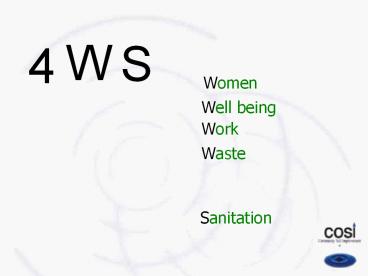Situation%20analysis - PowerPoint PPT Presentation
Title:
Situation%20analysis
Description:
For improved health and socio economic development in peri urban coastal ... Live fence compost bin school yard. Failed because of pigs ... – PowerPoint PPT presentation
Number of Views:56
Avg rating:3.0/5.0
Title: Situation%20analysis
1
W
S
4
Women
Well being
Work
Waste
Sanitation
2
What is 4WS?
- An action research
- On alternative strategies of environmental
sanitation and waste management - For improved health and socio economic
development in peri urban coastal communities in
South Asia
3
- Funded by EU
- Regional Program
- Bangladesh(Kulhna)
- India(Kerala)
- Sri Lanka(Karukupane)
- Duration - 3 years
- Work with sub-national NGOs universities
4
Sri Lanka - Karukupane
Karukupane
5
Background of the Intervention Community
(Karukkupone)
Rapidly growing small fishing village
- Population 1606 in 389 house holds
- Religion- 97 Roman Catholics
- Education Primary (2 schools, Sinhalese and
Tamil)
- Total area is less than five square
kilometers - The rainfall is lt120mm.
- Temperature is more than 26ºC.
- Women involvement- work in the fish production
process, weave mats, involve in poultry and pig
farming
6
During the southwest monsoon the sea roughens and
many fishermen stop fishing and migrate(with
their families) to the Northeastern coast on a
seasonal basis, to fish on calmer seas there.
7
- Education Primary (2 schools, Sinhalese and
Tamil)
8
Demand creation
COSI Intervention
- Enhance awareness
- Mobilization
- Motivation
- Active Participation
- Strengthening
- Resource management
- waste management
- water management
- energy saving
Establishing a mechanism
9
Enhance awareness, Mobilization, Motivation
Social mapping
posters
Neighborhood group meetings
10
Active participation
11
Wealth Ranking
12
Activities with School Children
13
Strengthening
Leadership training program for Youth Club
Training for women masons
Innovative approaches for economic strengthening
14
Masonry among village women
15
Waste management
Live fence compost bin school yard
Failed because of pigs
Introduction of separation of garbage
16
Separated Plastics and Glass
17
PLASTIC AND POLYTHENE, WE DO NOT DISPOSE WASTE
HARMFULLY TO THE ENVIRONMENT
The separation bag designed for Non degradable
material
For degradable matter
18
Challange- NO SPACE!!!
19
water
29 used water from pits dug on sand
Rest from the water vendor
20
This low land where rain water gets accumulated
is considered as the source for recharging the
PALIYA
PALIYA where they dig sand for water
21
Solutions
Seven Rain water harvesters
10 households practice SODIS
22
Construction of a rain water harvester
23
From Traditional stove
To Smokeless stove
24
Adoption of good practices
Good Hygienic Practices Appropriate sanitary
practices
25
Before.
26
After
27
SANITATION
After.
Before..
- The number of people who used alternative places
for defecation has lowered by about 40. - People are now aware of the importance of safe
defecation and they are ready to go for lower
options of the sanitation ladder.
28
Over hung toilet over the lagoon
An abandoned toilet
29
Solutions.
Water sealed latrine
Cost too high, not affordable
30
- Solution..
- Introduction of low cost Ecosan toilet
- Pit lined with used tyres
- Superstructure with wooden planks and GI sheets
- Cost LKR 2500 / 24 USD
31
1
2
3
Steps of construction of a dry pit latrine lined
with used tyres
32
4
5
7
6
33
Characteristics of the Ecosan toilet
- Low cost, Low tech
- Re usage of materials
- Tyres, barrels
- Broken tile pieces for the concrete
- Water, urine diverted in to a plastic barrel
- (tree is planted nearby)
34
- Thank you































